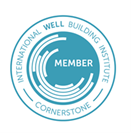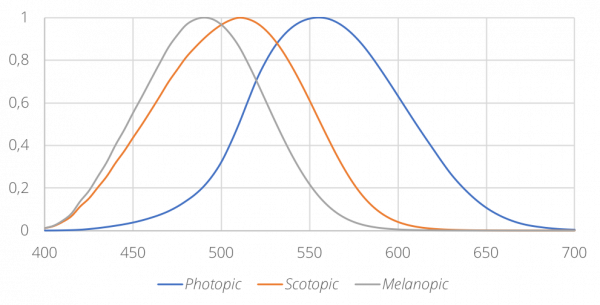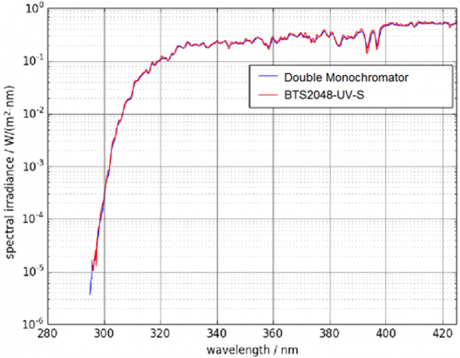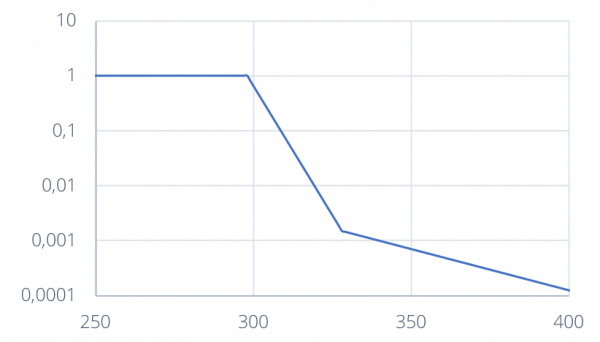Spectroradiometer Requirements for LED Binning
Need for LED Binning
Despite the most sophisticated manufacturing technologies employed by the semiconductor industry, light output and colour temperature of LEDs varies from chip to chip. Therefore, binning is employed to maximise yields and to categorise products. Standards such as ANSI C78.377-2017 [1] define tolerance bands or ‘bins’ with respect to chromaticity boundaries.
Therefore, without exception, LED binning requires the absolute spectral power distribution of devices to be measured in order to precisely determine the light output and the correlated colour temperature (CCT) of each individual LED. Light output is most commonly measured in terms of luminous flux (lm) although Averaged LED Intensity [2] is also sometimes specified.
LEDs are mass produced necessitating the shortest possible measuring times for binning purposes.
High Speed Testing Binning Measurement Systems
Manufacturers test their devices using a single pulse with typical durations of around 20 ms or less. This high speed testing places great demands on the spectroradiometer requiring high light throughput of the input optics, high sensitivity and the smallest possible dark signal as well as fast data processing and data transmission. Additionally, the software must provide for easy integration of the measuring device into complete automated systems. With the BTS2048-VL spectroradiometer and its measurement accessories for luminous flux and Averaged LED Intensity, Gigahertz-Optik GmbH offers a high-performance measuring device for LED binning.
References
[1] Specifications for the Chromaticity of Solid State Lighting Products, ANSI C78.377-2017
[2] CIE 127:2007 Measurement of LEDs
Light Measurement Requirements for Human Centric Lighting
Contemporary scientific research has shown that in addition to the cones and rods that provide us with color and night-time vision respectively, our retinas also have non-image forming photoreceptors, called intrinsically photosensitive retinal ganglion cells (ipRGCs), which play a major role in entraining our circadian rhythms. Of particular interest is the spectral responsivity of ipRGCs which contain a photopigment called melanopsin. Whereas our cones and rods have spectral responsivities defined by the V(λ) and V’(λ) functions for photopic and scotopic vision, ipRGCs have their own ‘melanopic’ spectral responsivity with peak sensitivity in the blue spectral region, around 480nm.
SSL Possibilities for HCL
Modern insights into human chronobiology combined with the possibilities of SSL lighting offer many new opportunities to improve health and wellbeing through appropriate lighting, most commonly referred to as ‘human centric lighting’ (HCL), but other terms such ‘circadian lighting’, ‘biodynamic lighting’ or ‘biologically-effective lighting’ are also regularly used.
In its basic form, HCL typically attempts to control the Correlated Color Temperature (CCT) of lighting in a way that emulates natural daylight. More sophisticated techniques involve the measurement of additional metrics such as melanopic illuminance (CIE TN 003:2015) [1] or Circadian Stimulus (LRC Rensselaer) [2]. The accurate measurement of all of these metrics requires spectral characterization of the lighting.
The measurement of ‘equivalent melanopic lux’ (EML or melanopic illuminance), as required by the WELL Building Standard [3] for example, and ‘melanopic daylight equivalent illuminance’ are standard features of all our spectral light meters, including the low cost MSC15-CS meter which is approved by the International WELL Building Institute for such measurements.


Works with WELL TM licensed by International WELL Building Institute

HCL Measurement Systems
HCL is not only concerned with our ipRGC response to the amount and timing of ‘blue light’ received. Rod and cone photoreceptors also contribute to our circadian phototransduction. Knowledge of other wavelengths may also prove useful to HCL designers. For example, ‘red light’ has been shown to increase alertness without suppressing melatonin. For research purposes, the CIE now recommends (CIE TN 003:2015) [1] reporting all of the 5 α-opic equivalent illuminances for s-cones, m-cones, l-cones, rods and ipRGCs. Accordingly, the BTS256-EF spectral light meter and the BTS2048-VL laboratory spectroradiometer report the following metrics:
| α-optic |
| unit |
| Ez | melanopic illuminance | z-lx |
| Ee,z | melanopic irradiance | W/m² |
| Ev,mel | melanopic daylight equivalent illuminance | lx |
| Esc | cyanopic illuminance | sc-lx |
| Ee,sc | cyanopic irradiance | W/m² |
| Emc | chloropic illuminance | mc-lx |
| Ee,mc | chloropic irradiance | W/m² |
| Elc | erythropic illuminance | lc-lx |
| Ee,lc | erythropic irradiance | W/m² |
| Er | rhodopic illuminance | r-lx |
| Ee,r | rhodopic irradiance | W/m² |
References
Measurement of non-Laser Optical Radiation Safety at Work
General Requirements
The European Directive 2006/25/EC [1] lays down minimum requirements for the protection of the health and safety of workers from the risks related to artificial optical radiation. It is implemented in law by all member states and covers exposure of skin and eyes to ultraviolet, visible and infrared (to 3000nm) radiation, both from coherent (laser) and non-coherent (non-laser) light sources. The exposure limit values in the directive are based on the work of the International Commission on Non-Ionizing Radiation Protection (ICNIRP) [2].
The methodology for determining exposure levels to laser radiation follows the well-established IEC 60825 [3] standard whereas for non-laser radiation the CIE/CEN standards in the form of EN 62471:2008 [4] is applicable.
Hazards relating to skin and the front surface of the eye require the measurement of irradiance whereas hazards to the eye itself require the measurement of radiance. EN 62471:2008 considers the following six hazards with respect to exposure over a period of up to eight hours:
| Hazard | Wavelength range | Bioeffect | |
| Eye | Skin | ||
| Actinic UV | (200 – 400)nm (*) | Cornea – photokeratitis Lens – cataractogenisis Conjunctiva – conjunctivitis | Erythema Elastosis |
| Near UV | (315 – 400)nm | Lens – cataractogenisis |
|
| Blue light | (300 – 700)nm (*) | Retina – photoretinitis |
|
| Retinal thermal | (380 – 1400)nm (*) | Retina – retinal burn |
|
| IR radiation eye | (780 – 3000)nm | Cornea – cornea burn |
|
| Thermal skin | (380 – 3000)nm |
| Skin burn |
| (*) Action spectra weighting applied | |||
Photobiological hazards considered in IEC EN 62471 and EU Directive 2006/25/EC
It should be noted that there are some minor differences between EN 62471:2008 and the limits in IEC 62471:2006 [5] with respect to blue light small source and retinal thermal weak stimulus limits that result from revisions in ICNIRP guidelines.
The X1-3 Hazard Optometer facilitates the measurement of all UV and blue light hazards within the scope of EN 62471. The XD-45-HUV hazard detector measures actinic UV and near UV irradiances and the XD-45-HB blue light hazard detector measures blue light weighted radiance within the required fields of view. With the stray light corrected BTS2048-UV spectroradiometer spectral measurements can be performed, see our scientific publication showing such sophisticated measurements using an array spectroradiometer.
References
[1] Directive 2006/25/EC - artificial optical radiation
[2] International Commission on Non-Ionizing Radiation Protection Guidelines
[3] IEC 60825-1:2014 Safety of laser products - Part 1: Equipment classification and requirements
[4] EN 62471:2008 Photobiological safety of lamps and lamp systems
[5] IEC 62471:2006 Photobiological safety of lamps and lamp systems
[6] EN 14255 Parts 1 and 2: Measurement and assessment of personal exposures to incoherent optical radiation
Erythema-Effective Irradiance Measurement of Sun Tanning Studios
Concerns over the safety of both commercial and home use sun tanning lamps led to the EU’s Scientific Committee on Consumer Products (SCCP) [1] recommending a limit of 0.3W/m2 erythema effective irradiance for all cosmetic use sun tanning lamps. This level is implemented within legally binding European regulations for both manufacturers and operators. Erythema is the reddening of the skin which is an inflammatory response caused by, for example, the actinic effect of exposure to UV radiation. Erythemal effective irradiance (CIE S 007-1998) [2] is measured over the wavelength range 250 nm to 400 nm.
Regulations for Sun Tanning Studios
Within Europe, sun tanning products must conform to the Low Voltage Directive (LVD) 2014/35/EU in order to be CE marked which requires type-testing against EN 60335-2-27- 2010 [3]. A high quality UV spectroradiometer such as the BTS2048-UV is required to measure the spectral irradiance of appliances, from which erythema effective irradiance is determined over UV-A and UV-B wavelength regions 250 nm - 320 nm (UV-B) and 320 nm - 400 nm (UV-A). Note that these UV ranges differ from standard CIE UV-A (315 - 400)nm and UV-B (280 - 315)nm wavelength ranges. The total UV-A plus UV-B effective irradiance must not be in excess of 0.3 Wm-2. Additionally, the un-weighted irradiance 250 nm - 280 nm must not exceed 0.003 Wm-2. Excellent scattered light rejection is required of the spectroradiometer otherwise products may unnecessarily fail this criterion. The appliance type is then determined using the following table:
| UV Appliance Type | 250 nm - 320nm ery-eff irradiance (W/m2) | 320 nm - 400 nm ery-eff irradiance (W/m2) | Application |
| 1 | < 0.0005 | > 0.15 | Professional use under supervision of appropriately trained persons. |
| 2 | 0.0005 to 0.15 | > 0.15 | Professional use under supervision of appropriately trained persons. |
| 3 | < 0.15 | < 0.15 | Suitable for household use without training. |
| 4 | > 0.15 | < 0.15 | Intended to be used following medical advice. |
Routine Inspection Measurement Equipment
Routine inspection and compliance checking by either the sun tanning studio operator or by local authority inspectors is more conveniently performed with a suitable UV radiometer such as the X1-4 meter. The XD-45-ERYC multi-detector based sensor supplied with the X1-4 meter also incorporates a UV-C irradiance detector for maximum safety compliance testing.
References
[2] CIE S 007-1998 Erythema Reference Action Spectrum and Standard Erythema Dose
[3] EN 60335-2-27:2013 Household and similar electrical appliances. Safety. Particular requirements for appliances for skin exposure to ultraviolet and infrared radiation
Measurement of Actinic and Safety-Related Irradiance of UV-C Air Disinfection
Shortwave UV-C radiation is highly bactericidal because it is absorbed by the DNA of microorganisms which destroys its structure. Referred to as ultraviolet germicidal irradiation (UVGI), UV-C wavelengths around (260-270) nm are most effective in combating airborne bacteria, viruses and other microorganisms such as mildews and yeasts. Disinfecting the air can prevent the transmission of a variety of airborne infections such as tuberculosis and pandemic influenza. It can also prevent contamination of raw materials and food. Therefore, UV-C air disinfection systems are being increasingly used within healthcare environments, public places, industry, and research facilities.
Requirements for UVC Air Disinfection Measurement Equipment
Manufacturers need to optimise the efficacy of the UV germicidal action of air purification systems whilst ensuring no hazard is presented to occupants. New developments in germicidal UV sources, of particular note are UV-C LED arrays (265-280)nm and far UV lamps such as excimer KrCl (222nm), require new calibration strategies in order to allow low measurement uncertainties. We offer spectral mismatch correction for all used UV sources.
Out specialist UV-C detectors and meters (UVC Radiometers) are designed to withstand the high-energy UV radiation present within air disinfection systems whilst offering the dynamic range to enable low level hazard measurements. To measure the irradiance of such extended sources, radiometers must be designed with a cosine field of view function. The required cosine-correction optics and photodetector components must also be pre-aged because of the high-energy UV radiation. Occupant safety [1] must be ensured for rooms fitted with ceiling-mounted air disinfection systems. The monitoring of exposure to UV-C [2] of long term occupants (e.g. healthcare workers [3]) within rooms fitted with air purification can be achieved with the use of personal dosimeters such as the X2000 dosimeter. For spectral measurements our high end spectroradiometers like the BTS2048-UV can be recommended.
Germicidal UV Standards
See also our application note about available Germicidal UV Standards. This list can give an quick overview about the diversity.
References
[2] MW First et al, Monitoring Human Exposures to Upper-Room Germicidal Ultraviolet Irradiation
[3] UV-C Exposure and Health Effects in Surgical Suite Personnel
Measurement and Evaluation of UV Radiation during Arc Welding
The use of personal protection equipment (PPE) is essential during welding processes due to the high levels of UV radiation produced. Evaluating the hazard associated with UV exposure during welding processes, requires the spectral irradiance to be measured and weighted in terms of biological effectiveness. The measurement of the dynamic optical processes within welding arcs requires specialist equipment as well as expertise in its use and evaluation of the measurement results.
Scientific Publication of UV Safety during Welding
The IFA, Sankt Augustin and the Federal Institute for Occupational Safety and Health, Dortmund have produced comprehensive research reportson the measurement and evaluation of UV radiation exposure during welding processes [1], including consideration of the dynamic aspects [2] .
Measurment Euquipment for UV Safety Measurements during Welding
The reports employ a wide range of specialist measurement equipment from Gigahertz-Optik GmbH, including UV spectroradiometers [3], UV radiometers [4][5] and personal dosimeters [6][7].
References
[1] IFA – Emission of UV radiation during arc welding
[2] Optische Strahlenbelastung beim Schweißen – Erfassung und Bewertung
[3] BTS2048-UV-S for high quality UV measurements
[4] P-9801 with XD45-HUV and XD-45-HB, fast 8-channel Optometer with ICNIRP UV and Blue light hazard detectors
[5] P-9710 Optometer with LDM-9811 radiance detector with 1,7 mrad for LB
[6] X2012-11 Data logger Dosimeter for ICNIRP actinic UV irradiance
[7] X2012-14 Data logger Dosimeter for radiometric UV-A und UV-B irradiance
Climatic Challenges for Outdoor Optical Radiation Measurements
Instrumentation for measuring solar radiation is often subject to extreme climatic conditions as much research is necessarily located high in mountain areas or other hostile environments such as the Arctic and Antarctic regions. For example, the High Altitude Research Station, Jungfraujoch (HSFJG) [1] Switzerland is located 3456 m above sea level. It has been the location for solar radiation measurements with both broadband radiometers and spectroradiometers since the 1980’s. One research project undertaken during the months of October and November investigated whether the broadband device WPD-UVA-03 (Gigahertz-Optik GmbH) was suitable as a monitor detector for relatively slow scanning spectroradiometers such as the Bentham DTM300 double monochromator.
The broadband measuring device was exposed to very demanding weather conditions.
"The BfS at the Schneefernerhaus - measurement of UV radiation at an altitude of 2666 m"Read less
Air temperatures on the Jungfraujoch ranged from + 5 °C to -18 °C with wind speeds of up to 150km/h. In addition, the device had to withstand sporadic icing. Third party comparison work by CMS Schreder concluded that the UV-A broadband meter had sufficient stability even under extreme weather conditions. Thus, it was very well suited as a monitor detector for quality control of spectroradiometers used for global solar radiation. A suitable broadband monitor detector can be used to reduce the inherent measurement uncertainties resulting from the long measuring times of scanning spectroradiometers (typically 2 minutes or more) which are due to short-term events such as passing clouds.

Comparison of solar measurements with BTS2048-UV-S and a double monochromator.
Conventionally, double monochromator based scanning spectroradiometers have been used for solar UV measurements due to their high scattered light performance. In 2017, Gigahertz-Optik GmbH introduced the weatherproof UV spectroradiometer BTS2048-UV-S-WP [2] for outdoor solar radiation measurements. Its BiTecSensor provides the benefits of a fast, high-resolution array spectroradiometer, but with excellent scattered light rejection combined with the properties of a broadband detector. The weatherproof BTS2048-VL-TEC-WP spectroradiometer is also available for outdoor solar radiation measurements in the visible and near-IR wavelength regions (to 1050nm).
References
Measurement of Solar Irradiance to Calculate the UV Index
The global solar UV index [1], UVI, is an internationally recognised measure primarily intended to inform the public about UV radiation health risks and sun protection. The UVI uses simple integer values, typically 0 to 11+, to describe the level of solar UV radiation at the Earth’s surface. The potential for damage to the skin and eyes increases and the time it takes for harm to occur will decrease as the UV index value increases. UVI values change continually throughout the day and vary widely depending on location [2] and the time of year. Daily histories and forecasts of UVI are generally reported for maximum values i.e. clear sky conditions at the local solar noon, when the Sun is highest in the sky.
Local UVI can be most accurately determined with measurement data from a suitably configured spectroradiometer. This is especially important to extend the network of simply integral measuring UVI index devices which might have larger errors due to spectral mismatch correction problems. A high end spectroradiometer like the BTS series can be a reference for such devices.
"The BfS at the Schneefernerhaus - measurement of UV radiation at an altitude of 2666 m"
| Exposure risk | UVI Range |
| Low | 0 – 2 |
| Moderate | 3 – 5 |
| High | 6 – 7 |
| Very High | 8 – 10 |
| Extreme | 11 + |
UVI Exposure categories
Absolute solar UV radiation levels on the ground are measured in terms of W/m2, the radiometric measure of irradiance. The CIE erythema action spectrum [3] models the tendency of caucasian skin to sunburn (erythema). UVI is derived from the effective erythema irradiance which is determined by integrating the actual UV irradiance, weighted by the CIE erythema action function. A UVI value of 1 equates to an effective erythema irradiance of 25 mW/m2.

CIE 1998 Erythema Action Spectrum
It is not possible to implement the erythema function very precisely with filter based broadband radiometers due to its wide dynamic range and steep decline in effectivity of more than 3 decades over a narrow spectral range. Consequently, public health and other research applications are best served by spectroradiometric measurements of solar irradiance. The resulting spectral irradiance data, W.m-2.nm-1, can be weighted by the exact erythema function to provide a precise evaluation of the effective erythema irradiance and hence UVI.
The extremely large intensity difference between the irradiance in the ultraviolet region and longer wavelengths within the solar spectrum is also a challenge for the spectroradiometer itself. Inevitably, some of this visible and near infrared radiation is ‘scattered’ within the instrument and may be erroneously detected as if it were UV radiation. Even seemingly negligible stray light becomes significant when weighted by the erythema function. Therefore, spectral measurements of UV solar irradiance have been made conventionally with double monochromator based spectroradiometers, due to their excellent scattered light rejection specification.

Comparison of solar measurements with BTS2048-UV-S and a double monochromator.
However, with its contemporary, CCD-based UV spectroradiometers BTS2048-UV-S (laboratory version) and BTS2048-UV-S-WP (weatherproof version) , Gigahertz-Optik GmbH offers a compact and cost-effective alternative [4] [5]. For more general purpose use the XD-9506 broadband radiometric detector with effective erythema irradiance responsivity is also available. The BTS2048-UV-S-WP series has been successfully validated according to WMO and in comparison to an Brewer in [4] and [6].
References
[1] WHO Global Solar UV Index – Practical Guide
[2] WHO Typical UVI values worldwide
[3] ISO 17166:1999(E)/CIE S 007/E-1998, “Erythema Reference Action Spectrum and Standard Erythema Dose”
Measurement of the Total Ozone Column from Direct Solar Irradiance
Ground level solar irradiance is dependent on various atmospheric parameters such as cloud cover, total ozone and aerosol content. Most of the atmosphere’s ozone is contained in the stratosphere, providing essential protection from the Sun’s harmful UV radiation. Ground-based spectroradiometer measurements of direct solar UV irradiance can be used to determine the Total Ozone Column, TOC [1]. This requires a spectroradiometer capable of tracking the solar zenith angle and measuring spectral irradiance within a narrow field of view. TOC can be determined by applying the Beer-Lambert law in conjunction with the known absorption characteristics of ozone over the 290-350nm wavelength range. Suitable modelling is required to minimise the influences of the other atmospheric attenuators [2].
Read More here: UV array spectroradiometer to measure the thickness of the ozone layer of the Earth's atmosphere
The compact BTS2048-UV-S-WP weatherproof UV spectroradiometer is ideally suited for use on sun-trackers to perform direct solar irradiance measurements. During an international inter-comparison [3] of total ozone measurements the instrument was verified with measurements of direct solar irradiance and subsequent TOC evaluations showing deviations of less than 1.5% to most other reference instruments.
References
[1] M. Huber et al., “Total atmospheric ozone determined from spectral measurements of direct UV irradiance,” Geophys. Res. Lett.22, 1995.
[2] A. Vaskuri et al., “Monte Carlo method for determining uncertainty of total ozone derived from direct solar irradiance spectra: Application to Izaña results”
LED
/assets/Uploads/BTS2048-GB-GD-360-V01.jpg
UV
/assets/Uploads/Gigahertz-Optik-BTS2048-UV-S-2.jpg
Not Just Another Spectrometer
Explore our High-End Spectroradiometer Series: BTS2048
From UV to IR
From LED-Bining to Outdoor Applications
User Stories
Together with Gigahertz-Optik, the experts in light measurement technology, ARRI has developed a high-precision calibration device designed for perfect repeatability for this measurement task. The highly stable, position-independent, compact and highly accurate in all specifications BTS2048-VL-TEC plays a decisive role here.
DCP Test Station for UV LEDs
Vektrex SMU and BTS2048